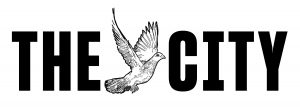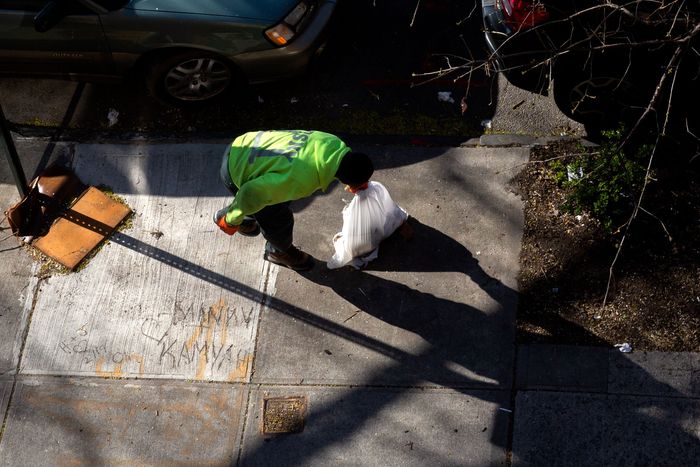By Gabriel Sandoval, Ann Choi and Rosa Goldensohn

This story was originally published on April 12, 2020 by THE CITY.
As many New Yorkers began to stay away from work, school and restaurants, city sanitation workers picked up more household trash last month than they did the previous March, statistics show — except, primarily, in parts of Manhattan.
Trash experts say the light trash loads in neighborhoods that include the Upper East Side, Upper West Side and East Village could reflect residents departing those areas as coronavirus spread.
Even as the Department of Sanitation collected 4.1% more tons of waste, recycling and compost citywide in March 2020 as it did during the same period last year — 255,555 tons total — Manhattan Community District 3 on the Lower East Side saw a 5% drop in trash tonnage.
Other areas saw smaller dips, including Harlem, SoHo, Chelsea and the West Village in Manhattan and Fordham, Hunts Point and Soundview in the Bronx.
Meanwhile, many parts of Queens and Staten Island have seen a marked increase in household garbage collected, approaching 12% in Astoria.
The shifts occurred during a month that saw a cascade of actions in New York that dispersed people to homes both in and outside the city. Those included shutdowns of college campuses and a statewide “PAUSE” order from Gov. Andrew Cuomo on March 20 that left only essential workers on the job.
Like ‘There’s Nobody’
Anecdotal accounts abound of well-heeled Manhattanites decamping for second homes in the Hudson Valley and the Hamptons.
Sally Afonso, 37, says the rest of her East Midtown townhouse has emptied out. One neighbor went upstate, while another couple headed back to North Carolina, where they had moved from. Her landlord, who usually lives next door, is also gone.
The only time she sees people other than her husband is when she goes out on her balcony to cheer for health care workers daily at 7 p.m.
She feels fortunate, though, to be able to work from home and stick it out safely in the city she loves. She is not envious of those who have left.
“I feel kind of like, when they come back, like they didn’t go through it,” she said.
Building service workers in upscale parts of Manhattan say they see the effects.
Joseph Alvarez, a porter at a Sutton Place-area building, estimates that half of the households have left for country homes.
He usually starts collecting garbage floor by floor, from the top floor down, first thing when he gets in to work in the morning.
“I do see a lot less garbage than what I normally would see when they’re there,” said Alvarez, 50.
Many residents are often away on weekends, he said. But since early March, he said, it’s as if every day is a Saturday.
“It just feels dead, it feels like there’s nobody there, even though there’s a few people that I know are there,” he said.
By contrast, he hears TVs blaring and the toddler upstairs in his Hollis, Queens, building.
Queens Community District 12, which includes Hollis, saw its garbage output jump 3.4% last month over March 2019 — while Manhattan Community District 6, where Alvarez works, saw a 2.6% decline.
“Actually,” said Alvarez, “everybody’s home in my building.”
‘Key Indicator’
To Robin Nagle, anthropologist in residence at the city Department of Sanitation, the trash trends may be telling the story of a city undergoing a seismic transformation.
“Garbage itself always, like a canary in a coal mine, is a key indicator of social change,” Nagle said.
“Manhattan is considerably wealthier than Queens, so I’m assuming more Manhattanites left the city, while more Queens residents have no choice but to shelter at home.”
The Upper East Side had a median household income of $133,850 in 2017, versus $67,650 in Astoria, Census figures show.

As household trash pickups surge in many areas, the Department of Sanitation has taken a “higher level approach,” shuffling workers to meet the demands of neighboring districts, said Belinda Mager, a spokesperson for the agency.
“Our operations staff look at the workers available, the work that needs to get done, and figures out the puzzle in the best way possible to get the job done,” she said.
Mager echoed the notion that crisis-driven shifts in population may be affecting the volume of waste.
“Some parts of Manhattan have had a significant decrease, potentially due to residents that have left the city during this crisis,” she said. “Other neighborhoods have seen increases in refuse tonnage, as residents are staying at home.”
Added Burdens
Workers say that the added burdens, compounded by the risks of illness inherent in hauling potentially infected waste, are taking a toll.
Sanitation worker Raymond Copeland died of complications related to COVID-19 on April 5, making him the first DSNY employee known to have died of the virus, the Queens Daily Eagle reported.
We mourn the passing of Sanitation Worker Raymond Copeland of Queens 12, who passed away of complications from COVID-19. He is our first employee to lose his life to this disease that has taken so many of our fellow New Yorkers. Our thoughts are with his family and friends. pic.twitter.com/qJRklJgeba
— NYC Sanitation (@NYCSanitation) April 7, 2020
As of Friday morning, 414 employees had tested positive for COVID-19, though a number have already returned to work, Mager said.
A Staten Island sanitation worker, who collects residential garbage and spoke on condition of anonymity, told THE CITY that shouldering the extra load has been “physically and mentally daunting.”
He’s lost sleep and fears falling ill.
“It’s kind of scary that I could sit there and do my job, but in the back of my mind, I have to worry about my health,” said the two-decade veteran of New York’s Strongest, who added he picked up respiratory illnesses from working in the wake of 9/11 and Hurricane Sandy.
“No matter how much work that we do — whether it’s in snow, 9/11, Sandy, the coronavirus — we are quickly forgotten as people who just don’t matter,” he added.
“We may not be considered first responders or ‘essential,’ but I know we see ourselves as the front line to the city.”
This story was originally published by THE CITY, an independent, nonprofit news organization dedicated to hard-hitting reporting that serves the people of New York.


































